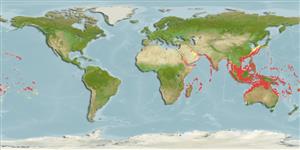>
Eupercaria/misc (Various families in series Eupercaria) >
Lutjanidae (Snappers) > Lutjaninae
Etymology: Lutjanus: Malay, ikan lutjan, name of a fish.
Environment: milieu / climate zone / depth range / distribution range
Écologie
marin récifal; profondeur 3 - 265 m (Ref. 11441), usually 30 - 150 m (Ref. 37816). Tropical; 20°C - 28°C; 35°N - 35°S, 31°E - 134°W (Ref. 55)
Indo-Pacific: Red Sea and East Africa to the Marquesas and Line islands, north to southern Japan, south to Australia. Southeast Atlantic: East London, South Africa (Ref. 5484).
Length at first maturity / Taille / Poids / Âge
Maturity: Lm 20.5, range 17 - 25 cm
Max length : 40.0 cm TL mâle / non sexé; (Ref. 4883); common length : 25.0 cm TL mâle / non sexé; (Ref. 55)
Épines dorsales (Total): 10; Rayons mous dorsaux (Total): 14-15; Épines anales 3; Rayons mous anaux: 7 - 8.
Adults inhabit coral reefs, occurring in both shallow lagoons and on outer reef slopes. Frequently found in large aggregations around coral formation, caves or wrecks during the day. Juveniles inhabit seagrass beds around patch reefs (Ref. 9710). Benthopelagic (Ref. 58302). Feed on fishes, shrimps, crabs, stomatopods, cephalopods, and planktonic crustaceans. Also take a variety of algae (Ref. 4821). Minimum depth reported taken from Ref. 30874.
Allen, G.R., 1985. FAO Species Catalogue. Vol. 6. Snappers of the world. An annotated and illustrated catalogue of lutjanid species known to date. FAO Fish. Synop. 125(6):208 p. Rome: FAO. (Ref. 55)
Statut dans la liste rouge de l'IUCN (Ref. 130435)
Menace pour l'homme
Harmless
Utilisations par l'homme
Pêcheries: commercial; pêche sportive: oui; Aquarium: Commercial
Outils
Articles particuliers
Télécharger en XML
Sources Internet
Estimates based on models
Preferred temperature (Ref.
123201): 19.1 - 28.3, mean 26.4 °C (based on 1181 cells).
Phylogenetic diversity index (Ref.
82804): PD
50 = 0.5000 [Uniqueness, from 0.5 = low to 2.0 = high].
Bayesian length-weight: a=0.01479 (0.01304 - 0.01678), b=2.97 (2.95 - 2.99), in cm total length, based on LWR estimates for this species (Ref.
93245).
Niveau trophique (Ref.
69278): 3.9 ±0.3 se; based on diet studies.
Résilience (Ref.
120179): Milieu, temps minimum de doublement de population : 1,4 à 4,4 années (K=0.21-0.38).
Prior r = 0.56, 95% CL = 0.37 - 0.85, Based on 1 stock assessment.
Fishing Vulnerability (Ref.
59153): Moderate vulnerability (40 of 100).
Climate Vulnerability (Ref.
125649): Moderate to high vulnerability (50 of 100).
Nutrients (Ref.
124155): Calcium = 32.2 [20.6, 44.6] mg/100g; Iron = 0.315 [0.209, 0.480] mg/100g; Protein = 18.3 [16.8, 19.6] %; Omega3 = 0.154 [0.114, 0.203] g/100g; Selenium = 74.6 [51.2, 104.5] μg/100g; VitaminA = 174 [34, 624] μg/100g; Zinc = 0.462 [0.381, 0.625] mg/100g (wet weight); based on
nutrient studies.
